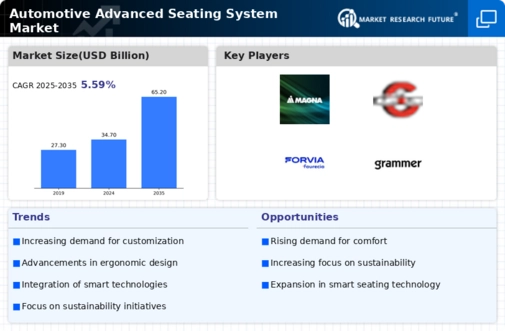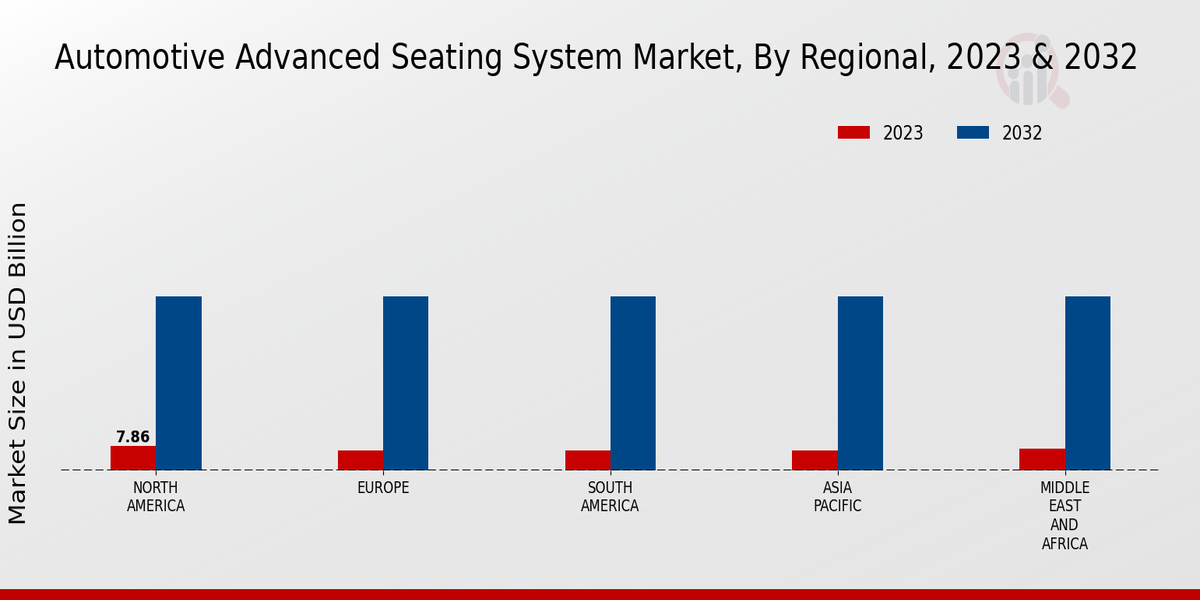Market Growth Projections
The Global Automotive Advanced Seating System Market Industry is poised for substantial growth, with projections indicating a market size of 34.7 USD Billion in 2024 and an anticipated increase to 65.2 USD Billion by 2035. This growth trajectory suggests a CAGR of 5.89% from 2025 to 2035, reflecting the increasing integration of advanced technologies and consumer preferences for comfort and safety in automotive seating. The market dynamics are influenced by various factors, including technological advancements, safety regulations, and the shift towards electric and autonomous vehicles, all contributing to the evolving landscape of automotive seating solutions.
Increasing Focus on Safety Features
Safety remains a paramount concern in the automotive sector, influencing the Global Automotive Advanced Seating System Market Industry. Manufacturers are increasingly incorporating advanced safety features into seating systems, such as integrated airbags, seatbelt pre-tensioners, and enhanced structural integrity. These innovations aim to protect occupants during collisions and improve overall vehicle safety ratings. The rising awareness of safety standards among consumers drives demand for vehicles equipped with such advanced seating technologies. Consequently, this focus on safety is expected to propel market growth, as consumers prioritize vehicles that offer both comfort and enhanced protection.
Growing Demand for Comfort and Luxury
The Global Automotive Advanced Seating System Market Industry experiences a notable surge in demand for comfort and luxury features in vehicles. Consumers increasingly prioritize ergonomic designs, adjustable seating, and premium materials, which enhance the overall driving experience. This trend is particularly evident in the luxury vehicle segment, where manufacturers integrate advanced seating technologies such as memory foam and climate control. As a result, the market is projected to reach 34.7 USD Billion in 2024, reflecting a robust consumer preference for high-quality seating solutions that cater to comfort and aesthetics.
Sustainability and Eco-Friendly Materials
The Global Automotive Advanced Seating System Market Industry is witnessing a shift towards sustainability, with manufacturers increasingly adopting eco-friendly materials in seating production. This trend aligns with global efforts to reduce environmental impact and meet consumer demand for greener products. For example, some companies are utilizing recycled plastics and bio-based materials in their seating systems. This not only reduces the carbon footprint but also appeals to environmentally conscious consumers. As sustainability becomes a key consideration in automotive design, the market is likely to benefit from this shift, fostering innovation and attracting a broader customer base.
Expansion of Electric and Autonomous Vehicles
The rise of electric and autonomous vehicles significantly influences the Global Automotive Advanced Seating System Market Industry. As these vehicles often prioritize innovative design and user experience, seating systems are evolving to accommodate new functionalities. For instance, autonomous vehicles may feature configurable seating arrangements that allow for more social interaction among passengers. This shift necessitates advanced seating solutions that cater to diverse needs and preferences. With the market projected to grow to 65.2 USD Billion by 2035, the expansion of electric and autonomous vehicles is likely to drive demand for sophisticated seating technologies that enhance passenger comfort and usability.
Technological Advancements in Seating Systems
Technological innovations play a pivotal role in shaping the Global Automotive Advanced Seating System Market Industry. The integration of smart technologies, such as automated adjustments, health monitoring systems, and connectivity features, enhances the functionality of seating systems. For instance, some manufacturers are incorporating sensors that adjust seat positions based on driver preferences or biometric data. This trend not only improves user experience but also aligns with the growing emphasis on personalization in automotive design. As these technologies evolve, they are expected to drive market growth significantly, contributing to an anticipated CAGR of 5.89% from 2025 to 2035.















